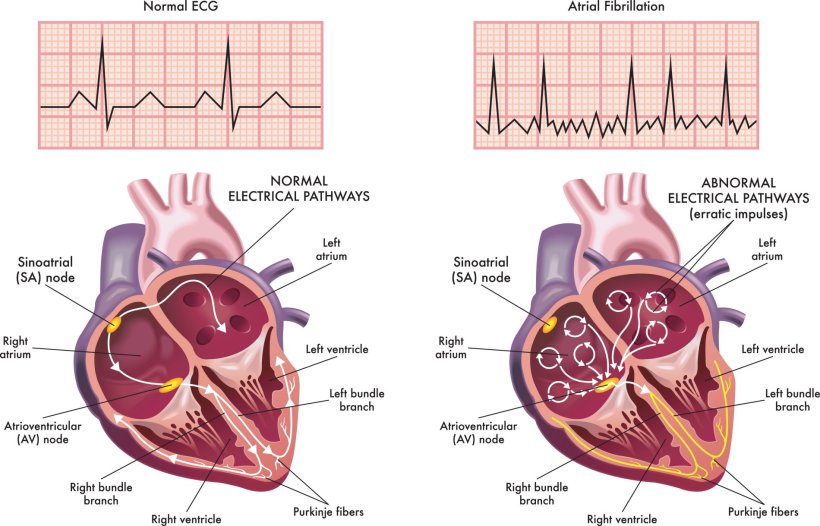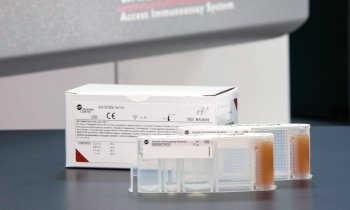© freshidea - stock.adobe.com
News • Heart rhythm disorder
Stroke prevention: experts recommend routine atrial fibrillation testing
People at risk should be tested for atrial fibrillation every time they attend a health appointment, according to results of the AFFECT-EU project.
Patients at high risk of the disorder, such as those with heart failure or prior stroke, should be invited for a screening test.
Scientific coordinator Professor Renate Schnabel of the University Hospital Hamburg-Eppendorf, Germany said: “Screening for atrial fibrillation can identify undiagnosed atrial fibrillation so that the condition can be managed according to guidelines, including starting anticoagulation medication to prevent strokes. AFFECT-EU has concluded that opportunistic screening, where at-risk groups are screened when they contact the healthcare system, plus targeting patients at particular risk, may be a productive and cost-effective way to implement screening across Europe.”
Atrial fibrillation is the most common heart rhythm disorder globally.1 The number of adults aged 55 years and older living with the condition in the European Union is expected to more than double from 8.8 million in 2010 to 17.9 million by 2060.2 People with atrial fibrillation are up to five times more likely to have a stroke than their healthy peers.1 The disorder often has no symptoms and remains undiagnosed until a stroke occurs.3,4

© rob3000 - stock.adobe.com
The four-year, EU-funded AFFECT-EU project brought together healthcare professionals, patient representatives, payers, and industry in a consortium of 26 partners, including the European Society of Cardiology (ESC), to define a feasible atrial fibrillation screening strategy for healthcare systems across Europe, with the ultimate aim of preventing subsequent strokes and premature death.
People with atrial fibrillation are more likely to be severely disabled or die from a stroke or heart failure than those without atrial fibrillation, making prevention an imperative to reduce morbidity and maintain a high quality of life
Daniel Engler
The ability of atrial fibrillation screening to reduce strokes was identified by the consortium in a contemporary meta-analysis in 35,836 participants.5 A further study by the consortium in 11 European countries found that there were no national screening programmes, and most atrial fibrillation was detected in patients with symptoms.6 But in a survey conducted by the group in 18 European countries, GPs said screening for atrial fibrillation was nearly as important as screening for common cancers.7 A subsequent analysis by project members demonstrated that screening result in savings of stroke-related costs regardless of the method (e.g. opportunistic or targeted). Project members then developed a budget impact analysis calculator that can be used by health regulators and payers to estimate the financial impact of implementing a screening programme over a five-year period.
Regarding who is at elevated risk of atrial fibrillation or stroke and should therefore be screened, studies by consortium members identified that the following are risk factors: increasing age, obesity, high blood pressure, and high blood levels of N-terminal pro B-type natriuretic peptide (NT-proBNP), which is commonly tested to diagnose heart failure.8-13
Project manager Daniel Engler of the University Hospital Hamburg-Eppendorf, Germany said: “People with atrial fibrillation are more likely to be severely disabled or die from a stroke or heart failure than those without atrial fibrillation,14 making prevention an imperative to reduce morbidity and maintain a high quality of life. AFFECT-EU has paved the way for well-implemented atrial fibrillation screening programmes to increase the number of new diagnoses, leading to guideline-adherent care, thereby reducing stroke risk and atrial fibrillation disease burden.”
References:
- Hindricks G, Potpara T, Dagres N, et al. 2020 ESC Guidelines for the diagnosis and management of atrial fibrillation developed in collaboration with the European Association for Cardio-Thoracic Surgery (EACTS). Eur Heart J. 2020;42:373-498.
- Krijthe BP, Kunst A, Benjamin EJ, et al. Projections on the number of individuals with atrial fibrillation in the European Union, from 2000 to 2060. Eur Heart J. 2013;34(35):2746-2751.
- Healey JS, Connolly SJ, Gold MR, et al. Subclinical atrial fibrillation and the risk of stroke. N Engl J Med. 2012;366(2):120-129.
- Samol A, Masin M, Gellner R, et al. Prevalence of unknown atrial fibrillation in patients with risk factors. Europace. 2013;15(5):657-662.
- McIntyre WF, Diederichsen SZ, Freedman B, et al. Screening for atrial fibrillation to prevent stroke: a meta-analysis. Eur Heart J Open. 2022;2(4):oeac044.
- Engler D, Hanson CL, Desteghe L, et al. Feasible approaches and implementation challenges to atrial fibrillation screening: a qualitative study of stakeholder views in 11 European countries. BMJ Open. 2022;12(6):e059156.
- Vermunicht P, Grecu M, Deharo JC, et al. General practitioners' perceptions on opportunistic single-time point screening for atrial fibrillation: A European quantitative survey. Front Cardiovasc Med. 2023;10:1112561.
- Morseth B, Geelhoed B, Linneberg A, et al. Age-specific atrial fibrillation incidence, attributable risk factors and risk of stroke and mortality: results from the MORGAM Consortium. Open Heart. 2021; 8(2):e001624.
- Camen S, Csengeri D, Geelhoed B, et al. Risk factors, subsequent disease onset, and prognostic impact of myocardial infarction and atrial fibrillation. J Am Heart Assoc. 2022;11(7):e024299.
- Toprak B, Brandt S, Brederecke J, et al. Exploring the incremental utility of circulating biomarkers for robust risk prediction of incident atrial fibrillation in European cohorts using regressions and modern machine learning methods. Europace. 2023;25(3):812-819.
- Palà E, Bustamante A, Clúa-Espuny JL, et al. Blood-biomarkers and devices for atrial fibrillation screening: Lessons learned from the AFRICAT (Atrial Fibrillation Research In CATalonia) study. PLoS One. 2022;17(8):e0273571.
- Xing LY, Diederichsen SZ, Højberg S, et al. Effects of atrial fibrillation screening according to N-terminal pro-B-type natriuretic peptide: A secondary analysis of the randomized LOOP study. Circulation. 2023;147(24):1788-1797.
- Xing LY, Diederichsen SZ, Højberg S, et al. Systolic blood pressure and effects of screening for atrial fibrillation with long-term continuous monitoring (a LOOP substudy). Hypertension. 2022;79(9):2081-2090.
- Alkhouli M, Alqahtani F, Aljohani S, et al. Burden of atrial fibrillation-associated ischemic stroke in the United States. JACC Clin Electrophysiol. 2018;4(5):618-625.
Source: European Society of Cardiology
19.03.2024











